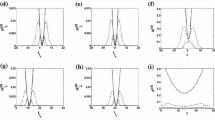Abstract
Consider the linear modelY=Xθ+E in the usual matrix notation where the errors are independent and identically distributed. We develop robust tests for a large class of one- and two-sided hypotheses about θ when the data are obtained and tests are carried out according to a group sequential design. To illustrate the nature of the main results, let\(\hat \theta\) and\(\tilde \theta\) be anM- and the least squares estimator of θ respectively which are asymptotically normal about θ with covariance matrices σ2(X t X)−1 and τ2(X t X)−1 respectively. Let the Wald-type statistics based on\(\hat \theta\) and\(\tilde \theta\) be denoted byRW andW respectively. It is shown thatRW andW have the same asymptotic null distributions; here the limit is taken with the number of groups fixed but the numbers of observations in the groups increase proportionately. Our main result is that the asymptotic Pitman efficiency ofRW relative toW is (σ2/τ2). Thus, the asymptotic efficiency-robustness properties of\(\hat \theta\) relative to\(\tilde \theta\) translate to asymptotic power-robustness ofRW relative toW. Clearly, this is an attractive result since we already have a large literature which shows that\(\hat \theta\) is efficiency-robust compared to\(\tilde \theta\). The results of a simulation study show that with realistic sample sizes,RW is likely to have almost as much power asW for normal errors, and substantially more power if the errors have long tails. The simulation results also illustrate the advantages of group sequential designs compared to a fixed sample design, in terms of sample size requirements to achieve a specified power.
Similar content being viewed by others
References
Billingsky, P. (1968).Convergence of Probability Measures, Wiley, New York.
Carroll, R. J. and Welsh, A. H. (1988). A note on the asymmetry and robustness in linear regression,Amer. Statist.,42, 285–287.
DeMets, D. and Ware, J. H. (1980). Group sequential methods for clinical trials with a one-sided hypothesis,Biometrika,78, 651–660.
DeMets, D. and Ware, J. H. (1982). Asymmetric group sequential boundaries for monitoring clinical trials,Biometrika,69, 661–663.
Giltinan, D. M., Carroll, R. J. and Ruppert, D. (1986). Some new estimation methods for weighted regression when there are possible outliers,Technometrics,28, 219–230.
Hajek, I. and Sidak, Z. (1967).Theory of Rank Tests, Academic Press, New York.
Hampel, F. R., Ronchetti, E. M., Rousseeuw, P. J. and Stahel, W. A. (1986).Robust Statistics: the Approach Based on Influence Functions, Wiley, New York.
Huber, P. J. (1977). Robust methods of estimating regression coefficientsMathematische Operationsforschung und Statistik, Series Statistics,8, 41–53.
Huber, P. J. (1981).Robust Statistics, Wiley, New York.
Huber, P. J. and Dutter, R. (1974). Numerical solutions of robust regression problems,Compstat 1974 (ed. G. Bruckmann), 165–172, Physika Verlag, Wien.
Jennison, C. and Turnbull, B. W. (1991). Group sequential tests and repeated confidence intervals,Handbook of Sequential Analysis (eds. B. K. Ghosh and P. K. Sen), Chapter 12, Marcel Deker, New York.
Krasker, W. S. and Welsch, R. E. (1983). Efficient bounded-influence regression estimation,J. Amer. Statist. Assoc.,77, 595–604.
Lan, K. K. G. and DeMets, D. L. (1983). Discrete sequential boundaries for clinical trials,Biometrika,70, 659–663.
Mallows, C. L. (1975). On some topics in robustness, Memorandum, Bell Telephone Laboratories, Mumay Hill, New Jersey (unpublished).
O'Brien, P. C. and Fleming, T. R. (1979). A multiple testing procedure for clinical trials,Biometrics,35, 549–556.
Pocock, S. J. (1977). Group sequential methods in the design and analysis of clinical trials,Bionetrika,64, 191–199.
Robertson, T., Wright, F. T. and Dykstra, R. L. (1988).Order Restricted Statistical Inference, Wiley, New York.
Schrader, R. M. and Hettmansperger, T. P. (1980). Robust analysis of variance based upon a likelihood ratio criterion,Biometrika,67, 93–102.
Sen, P. K. (1981).Sequential Nonparametrics, Wiley, New York.
Siegmund, D. (1980). SequentialX 2 andF tests and the related confidence intervals,Biometrika,67, 389–402.
Silvapule, M. J. (1985). Asymptotic behaviour of robust estimators of regression and scale parameters with fixed carriers,Ann. Statist.,13, 1490–1497.
Silvapule, M. J. (1992). Robust Wald-type tests of one-sided hypotheses in the linear model,J. Amer. Statist. Assoc.,87, 156–161.
Simpson, D. G., Ruppert, D. and Carroll, R. J. (1990). One-stepGM-estimates for regression with bounded influence and high breakdown point (unpublished).
Whitehead, J. (1983).The Design and Analysis of Sequential Clinical Trials, Ellis Horwood, Chichester.
Yohai, V. J. and Zamar, R. H. (1988). High breakdown-point estimates of regression by means of the minimization of an efficient scale,J. Amer. Statist. Assoc.,83, 406–413.
Author information
Authors and Affiliations
About this article
Cite this article
Silvapulle, M.J., Sen, P.K. Robust tests in group sequential analysis: One- and two-sided hypotheses in the linear model. Ann Inst Stat Math 45, 159–171 (1993). https://doi.org/10.1007/BF00773676
Received:
Revised:
Issue Date:
DOI: https://doi.org/10.1007/BF00773676




